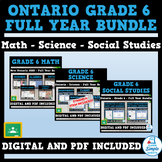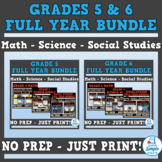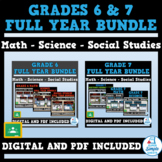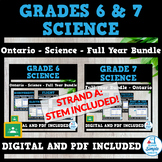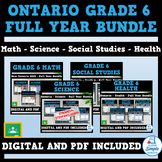NEW 2022 Curriculum! Ontario Grade 6 - Science STEM - Full Year Bundle
- Zip
- Google Apps™

What educators are saying
Products in this Bundle (4)
Also included in
- FULL YEAR SPLIT GRADE BUNDLE - GRADES 5 & 6! NEWLY UPDATED IN 2022! BOTH GOOGLE AND PDF VERSIONS INCLUDED!This bundle covers all expectations New Ontario 2022 Science Curriculum - Grades 5 & 6.***Strand A: STEM/Coding has been added to this unit at no extra charge!These massive units containPrice $58.00Original Price $72.00Save $14.00
- BOTH GOOGLE SLIDES AND PDF VERSIONS INCLUDED!FULL YEAR BUNDLE - Teaching made easy! This NO PREP bundle includes everything you need to teach Math, Science and Social Studies. It covers all the expectations in the Ontario curriculums.Grade 6 - New Ontario Math Curriculum 2020 – This bundle covers alPrice $88.00Original Price $108.95Save $20.95
- FULL YEAR BUNDLE - Split Grade Teaching made easy! This NO PREP - JUST PRINT bundle includes everything you need to teach Math, Science and Social Studies. It covers all the expectations in the Grades 5 & 6 Ontario curriculums. Grade 5 - New Ontario Math Curriculum 2020 – This bundle covers allPrice $165.00Original Price $217.90Save $52.90
- FULL YEAR BUNDLE - Teaching made easy! This DIGITAL AND PDF bundle includes everything you need to teach Math, Science and Social Studies. It covers all the expectations in the Ontario Grade 6 & 7 curriculums. Grade 6 - New Ontario Math Curriculum 2020 – This bundle covers all expectations in thPrice $165.00Original Price $248.39Save $83.39
- FULL YEAR SPLIT GRADE BUNDLE - GRADES 6 & 7! NEWLY UPDATED IN 2022! BOTH GOOGLE AND PDF VERSIONS INCLUDED!This bundle covers all expectations New Ontario 2022 Science Curriculum - Grades 6 & 7.***Strand A: STEM/Coding has been added to this unit at no extra charge!These massive units containPrice $58.00Original Price $72.00Save $14.00
- BOTH GOOGLE SLIDES AND PDF VERSIONS INCLUDED!FULL YEAR BUNDLE - Teaching made easy! This NO PREP bundle includes everything you need to teach Math, Science, Social Studies and Health. It covers all the expectations in the Ontario curriculums.Grade 6 - New Ontario Math Curriculum 2020 – This bundle cPrice $100.00Original Price $136.45Save $36.45
Description
NEW 2022 CURRICULUM! BOTH GOOGLE SLIDES AND PDF VERSIONS INCLUDED!
***Strand A: STEM/Coding has been added to this unit at no extra charge!
Check out the previews of this unit to learn more about how it can benefit your students. We know you will love this no-prep, just print, time-saving resource!
Most importantly, we have made cross-curriculum connections to the grade 6 language program. Students will practice reading comprehension strategies (making connections, questioning, visualizing, and inferencing) as they work through this unit.
Unit 1 - Biodiversity
- What is biodiversity?
- Difference between organisms, species, and communities
- Biodiversity around the world – Canada vs Amazon Rainforest
- Altering the food chain – effects on biodiversity
- Classification systems
- 5 kingdoms of living things – plants, animals, fungi, protists, monerans
- Microscopic organisms
- Animal classifications – vertebrates and invertebrates
- Mammals – primates
- Consumers and producers – herbivores, carnivores, and omnivores
- Classifying animals
- Plants – seed plants vs bulb plants
- Flowering plants vs non-flowering plants
- Vascular plants vs non-vascular plants
- Biodiversity within species – brown organisms versus white
- Adapting species – white rabbits vs brown rabbits in the arctic
- Darwin’s finches – natural selection causing adaptations
- Genetic variation – Black Peppered Moth and White Peppered Moth
- Biodiversity between species – 8 species of bears
- Biodiversity between species – bats (microbats and megabats)
- Relationships within species – wolf pack
- Symbiotic relationships – communalism, mutualism, parasitism
- Invasive species – Zebra Mussels (animals) and Phragmites (plants)
- Climate change – biodiversity
- Effects of melting glaciers on biodiversity
- Biodiversity and Indigenous communities
- Biodiversity and agriculture – soil, livestock, and crops
- Benefitting from biodiversity
- Biodiversity in our community
- STEM Activities
- Hands on Experiments
- Building models, systems, or structures
- Reading and writing code
- Coding – Creating models to map invasive species
- Unit test
- Answer pages for all activities
Unit 2 - Flight
- History of aviation
- Properties of air related to flight
- Air is a fluid
- Science experiment - power of air pressure
- Science experiment – air compression
- Four forces of flight – drag, thrust, lift, weight (gravity)
- Lift – Bernoulli’s Principle and Newton’s Third Law of Motion
- Angle of Attack – generating lift
- Drag – aerodynamics
- Science experiment – creating a paper airplane (testing drag)
- Weight/Gravity – effect on flight (luggage)
- Mass vs weight – reading, activity, and experiment
- Thrust (propulsion) – reading, activity
- Science experiment – building a propeller
- Control surfaces of a plane – parts of a plane and how they balance the plane
- How animals fly
- Animal adaptations – dolphins and swallows
- Design features of flying devices and flying organisms – adapting drag
- Race cars using spoilers to prevent lift
- Aircrafts versus spacecrafts
- Parachutes – how they use air resistance (drag) to slow down aircrafts/people
- Science experiment – building and testing a parachute
- Lighter-than-air flying devices
- Science experiment - making a glider
- Benefits and drawbacks of aviation
- Assignment – creating an infographic about aviation
- STEM Activities
- Hands on experiments
- Building models, systems, and structures
- Reading and writing code
- Autopilot – using code to fly planes
- Unit test
- Answer pages for all activities
Unit 3 - Electricity
- Forms of energy
- What is electricity?
- Electrical devices we use
- Electrostatic force
- Static electricity and current electricity
- Dangers of static electricity and current electricity
- How electricity works
- Dangers of short circuits
- Generating electricity – turbines and generators
- Conducting materials and insulating materials
- Lab experiment – conductors vs insulators
- Simple electrical circuits
- Reading circuit diagrams
- Drawing circuit diagrams
- Components of simple electrical circuits
- Series vs parallel circuits
- Electromagnetic forces
- Lab experiment – creating an electromagnet
- Transforming electricity into other forms of energy (heat, sound, and mechanical energy)
- Transforming electricity – the electric bell
- Electromagnetism and turbines (mechanical energy)
- Renewable vs non-renewable forms of energy
- Impacts of using electricity – downsides of different sources of electricity (solar, nuclear, wind, hydro, geothermal)
- How solar, nuclear, wind, and hydro energy transform into electricity
- Research assignment – the James Bay Hydroelectric Project
- Measuring electricity in our homes
- Reading energy efficient labels – household appliances
- Evaluating your use of electricity – making a plan to reduce usage
- STEM Activities
- Hands on Experiments
- Building models, systems, or structures
- Reading and writing code
- Binary code – computer language for electronics
- Remote controls using binary code
- Unit test
- Answer pages for all activities
Unit 4 - Space
- The Universe, Solar System, Galaxies, Planets
- Diagram of our Solar System
- Size of the Universe, Solar System, Milky Way Galaxy
- Assignment – planet profile
- Natural Satellites – moons
- Asteroids and the Asteroid Belt
- Meteors, meteorites, and meteoroids
- Identifying celestial bodies
- Gravity – reading and science experiment
- Mass versus weight – activity, reading, and experiment
- Celestial bodies that reflect or emit light
- Constellations – stars in our galaxy
- Experiment – creating constellations on geoboards
- Conception of the Earth – Flat Earth, Geo-Centred Theory, and Sun-Centred Theory
- Day and night – Earth’s axis and rotation
- Day and night around the world – research assignment
- Experiment – making a sundial
- Seasons – Earth’s orbit around the Sun
- Moons in our solar system – research assignment
- Phases of the moons – reading and experiment
- Ocean tides – lunar and solar tides
- Celestial objects visible in the night sky
- Canada and space exploration – technologies created by Canadians
- Space – extreme environment – temperature, zero gravity, air pressure
- Surviving in space – technologies needed
- Benefits of space exploration – using satellites
- Understanding climate change using space technologies – satellite images
- Mars Rovers – reading and research activity
- Controversy of space travel – downsides (dangerous and costly)
- Unit test
- STEM Activities
- Hands on Experiments
- Building models, systems, or structures
- Reading and writing code
- Coding – Creating models to investigate planets
- Answer pages for all activities
This is a comprehensive bundle that will save you hours of planning! It has been tested and found effective in helping students achieve the learning goals in the NEW science curriculum.
Follow Super Simple Sheets for more resources like this one!



